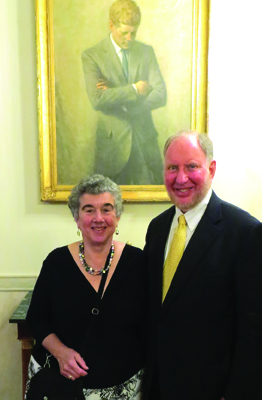Planning Today for Tomorrow

Robert ’63 and Rosemary Werner Putnam ’62 visited the White House this summer, when Bob received the National Humanities Medal. Their pose in front of the Kennedy portrait is significant, he says. “Since we are of the generation inspired by JKF’s admonition to ‘ask what you can do for your country,’ it helps capture why we want to give back to Swarthmore.” Photo by Jonathan Putnam
While James A. Michener ’29 proved the benefits of smart estate planning back in the 1990s, other Swarthmoreans are doing so today. Robert Putnam ’63, himself the author of groundbreaking works such as Bowling Alone: The Collapse and Revival of American Community, and wife Rosemary Werner Putnam ’62, a retired teacher, chose to provide for Swarthmore by making the College the beneficiary of their tax-sheltered retirement accounts. This is a tax-wise strategy, as the Putnams did not pay income taxes when the funds moved into their retirement accounts, and Swarthmore will not pay income taxes on these funds when they are received.
“Several years ago, when we started to think about the question of our will, it was natural for both of us to assume that Swarthmore would be a major recipient,” Rosemary explains. Adds her husband, “It happened that this June was simultaneously both my 50th Swarthmore reunion and, a week later, our 50th wedding anniversary. It seemed that the timing was right.”
Referring to the movie Pay It Forward, Rosemary notes that, in that spirit, their gift “seems a natural thing to do as a way to acknowledge the part that Swarthmore played in our lives. Swarthmore has played a part in our being able to be successful, and we feel very fortunate that we’ve been successful enough that we can afford to do this.”
Rosemary spent her working life as a special education teacher in public and private schools and now volunteers for two Boston-area schools. Bob is the Peter and Isabel Malkin Professor of Public Policy at Harvard. Their professional and personal interests “concentrate our attention on the issue of the accessibility of colleges to poor kids,” he says.
Although their gift has no restrictions on how it will be used, he says, “President Rebecca Chopp shares our view that a very high priority for college and universities everywhere in America is to be sure that economic barriers don’t come between talented kids and good schools. I’m certain that financial aid will always be a priority of Swarthmore, and we want to underpin that priority.”
Estate commitments like the Putnams’ are not the only way to plan ahead to support Swarthmore’s future needs. Some planned gifts even pay an income during your life, with the remainder passing to the College. Another matchbox couple, Richard S. Wilson ’73 and Emily Howe Wilson ’72, chose to do so through a charitable gift annuity (CGA). (See facing page for more details.) If you don’t require the income now but may once you retire, you can fund a deferred-payment CGA and receive a more beneficial annuity rate while qualifying for an immediate charitable income-tax deduction. Another option is to arrange a charitable trust, as Warren Uchimoto ’45 did recently. (See Page 28 for more details.)
Swarthmore’s gift planning staff works in partnership with you and your financial advisers to ensure that your gift accomplishes your intentions.
For more information about planned gifts, go to pg.swarthmore.edu or contact Mike Valoris, senior gift planning counsel, at mvalori1@swarthmore.edu or 610-328-8334.
 Email This Page
Email This Page